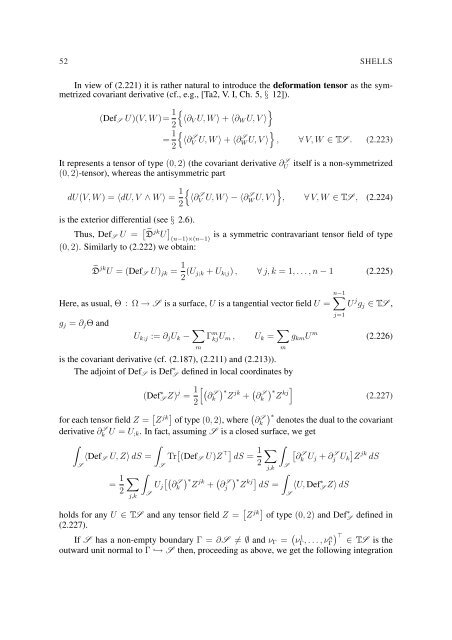EQUATIONS OF ELASTIC HYPERSURFACES
EQUATIONS OF ELASTIC HYPERSURFACES
EQUATIONS OF ELASTIC HYPERSURFACES
Create successful ePaper yourself
Turn your PDF publications into a flip-book with our unique Google optimized e-Paper software.
52 SHELLS<br />
In view of (2.221) it is rather natural to introduce the deformation tensor as the symmetrized<br />
covariant derivative (cf., e.g., [Ta2, V. I, Ch. 5, § 12]).<br />
(Def S U)(V, W )= 1 {<br />
}<br />
〈∂ V U, W 〉 + 〈∂ W U, V 〉<br />
2<br />
= 1 {<br />
}<br />
〈∂V S U, W 〉 + 〈∂W S U, V 〉 , ∀ V, W ∈ TS . (2.223)<br />
2<br />
It represents a tensor of type (0, 2) (the covariant derivative ∂U<br />
S<br />
(0, 2)-tensor), whereas the antisymmetric part<br />
dU(V, W ) = 〈dU, V ∧ W 〉 = 1 2<br />
itself is a non-symmetrized<br />
{<br />
}<br />
〈∂V S U, W 〉 − 〈∂W S U, V 〉 , ∀ V, W ∈ TS , (2.224)<br />
is the exterior differential (see § 2.6).<br />
Thus, Def S U = [ ˜Djk U ] (n−1)×(n−1)<br />
(0, 2). Similarly to (2.222) we obtain:<br />
is a symmetric contravariant tensor field of type<br />
˜D jk U = (Def S U) jk = 1 2 (U j;k + U k;j ) , ∀ j, k = 1, . . . , n − 1 (2.225)<br />
∑n−1<br />
Here, as usual, Θ : Ω → S is a surface, U is a tangential vector field U = U j g j ∈ TS ,<br />
g j = ∂ j Θ and<br />
U k;j := ∂ j U k − ∑ Γ m kjU m , U k = ∑<br />
m<br />
m<br />
j=1<br />
g km U m (2.226)<br />
is the covariant derivative (cf. (2.187), (2.211) and (2.213)).<br />
The adjoint of Def S is Def ∗ S defined in local coordinates by<br />
(Def ∗ S Z) j = 1 2[ (∂<br />
S<br />
k<br />
) ∗Z jk + ( ∂ S k<br />
) ∗Z kj]<br />
(2.227)<br />
for each tensor field Z = [ Z jk] of type (0, 2), where ( )<br />
∂k<br />
S ∗<br />
denotes the dual to the covariant<br />
derivative ∂k S U = U ;k. In fact, assuming S is a closed surface, we get<br />
∫<br />
∫<br />
〈Def S U, Z〉 dS = Tr [ (Def S U)Z ⊤] dS = 1 ∑<br />
∫<br />
[ ]<br />
∂<br />
S<br />
S<br />
S 2<br />
k U j + ∂j S U k Z jk dS<br />
j,k<br />
S<br />
= 1 ∑<br />
∫<br />
[( )<br />
U j ∂<br />
S ∗Z jk<br />
2<br />
k + ( ) ∗Z<br />
∂ ] ∫<br />
j<br />
S kj<br />
dS = 〈U, Def ∗ S Z〉 dS<br />
j,k<br />
S<br />
holds for any U ∈ TS and any tensor field Z = [ Z jk] of type (0, 2) and Def ∗ S defined in<br />
(2.227).<br />
If S has a non-empty boundary Γ = ∂S ≠ ∅ and ν Γ = ( ν 1 Γ , . . . , νn Γ) ⊤<br />
∈ TS is the<br />
outward unit normal to Γ ↩→ S then, proceeding as above, we get the following integration<br />
S

















